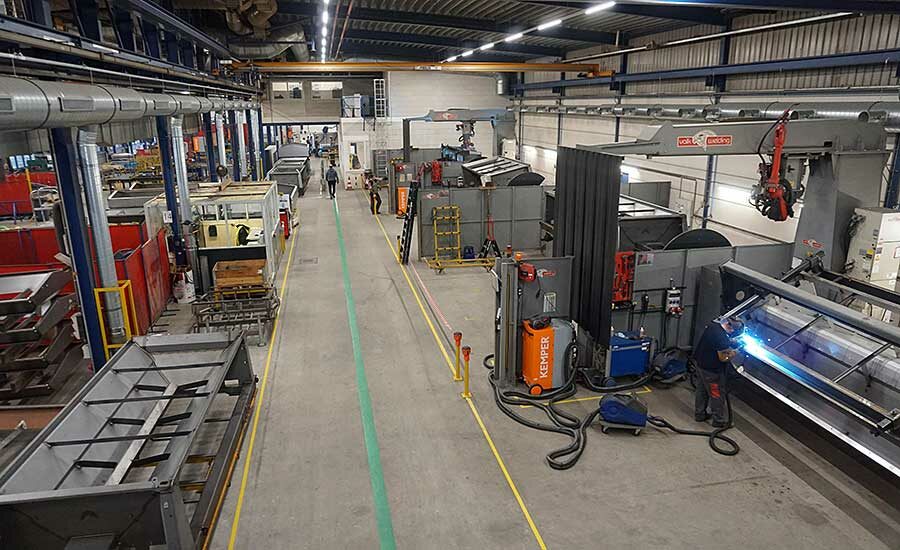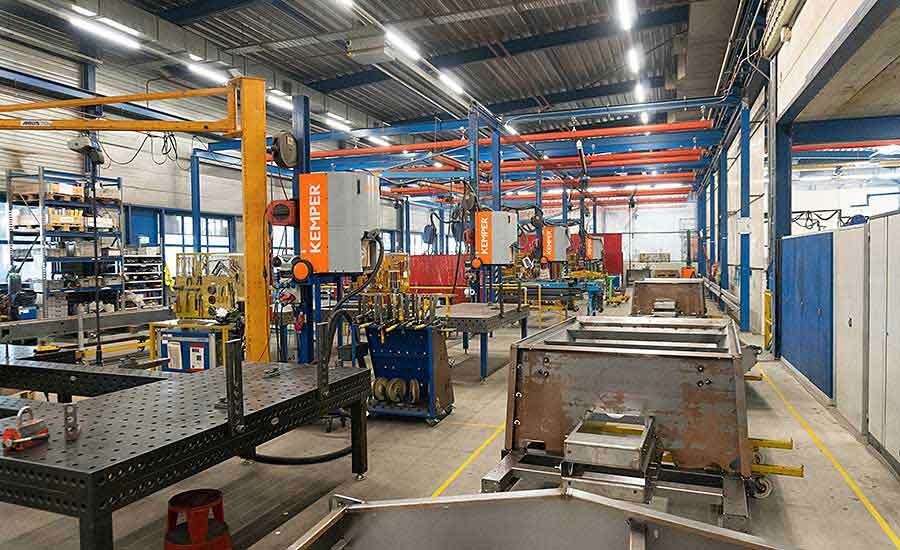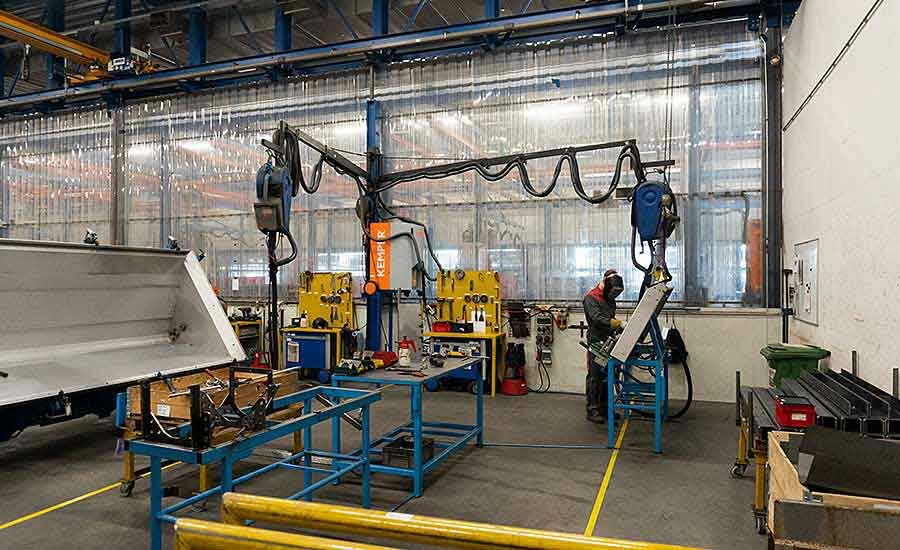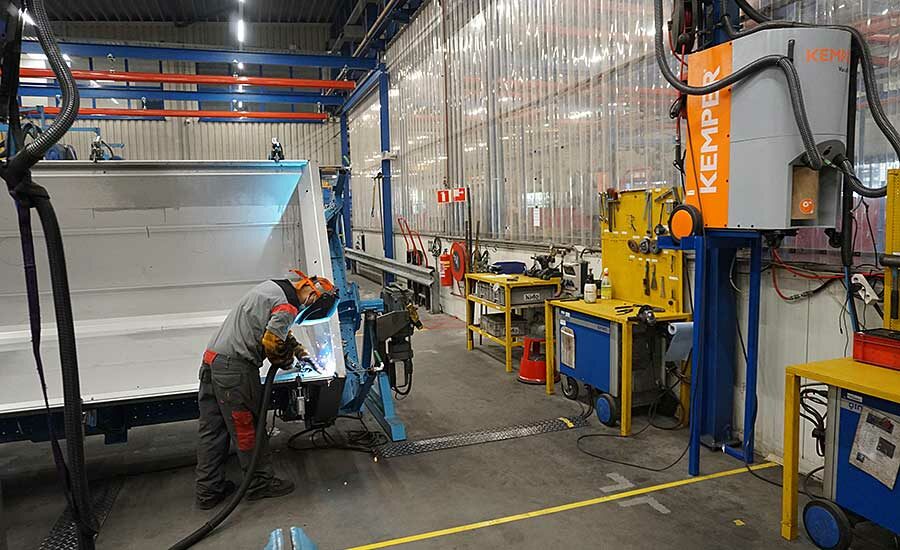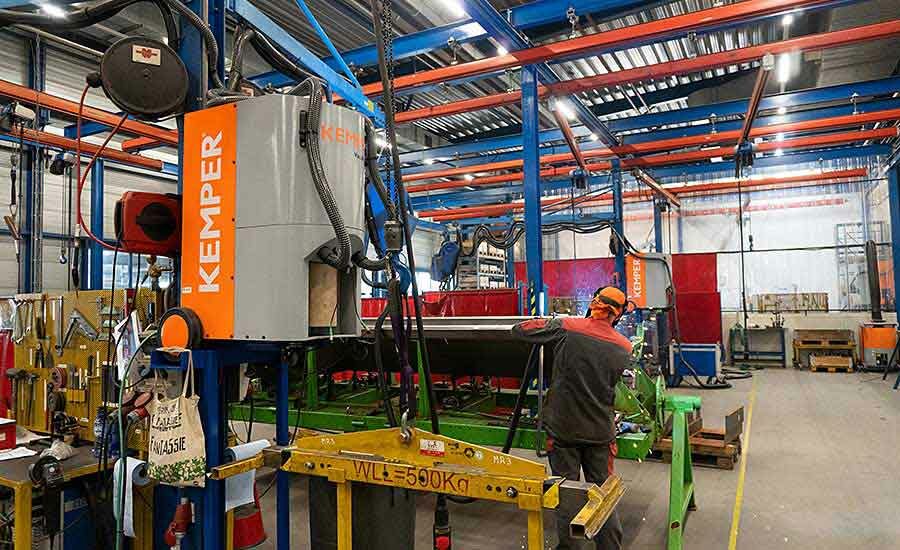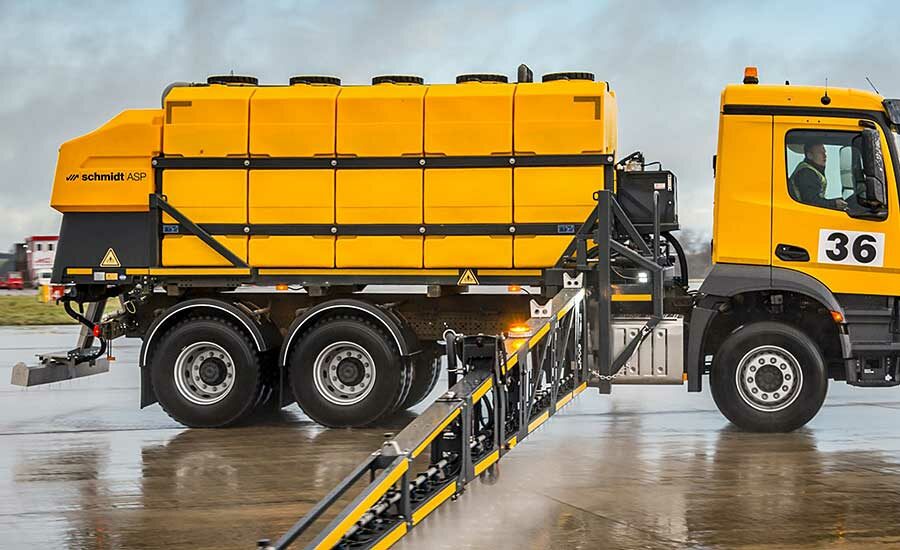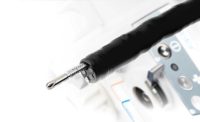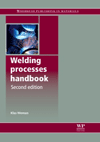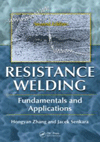The Aebi Schmidt Group is a global manufacturer of snow removal equipment, pavement marking machines, street sweepers and other specialty equipment. The company operates 12 assembly plants in Europe and North America.
The company’s assembly plant in Holten, The Netherlands, manufactures spreaders, airport sprayers, truck-mounted sweepers and other machinery for keeping roads and runways safe, clean and ice-free. Gas metal arc welding—both robotic and manual—is used throughout the factory to assemble the company’s products.
Although the quality of the air inside the factory was at an acceptable level, it was typically close to the maximum legal provisions. Compared with other countries, the Netherlands has one of the lowest workplace exposure limits for manufacturing facilities. However, Aebi Schmidt wanted to improve the air quality even further and lower the concentration of hazardous substances to below the prescribed limit of 1 milligram per cubic meter, particularly in the welding shop.
“One focus at Aebi Schmidt was clearly on improving working conditions,” emphasizes facility manager Steven Koenderink. “Air quality was one of the central issues here.”
For example, the company wanted to completely eliminate hazardous substances with lung-damaging, toxic or carcinogenic effects, particularly those generated during metal inert gas welding and metal active gas welding processes used to manufacture heavy steel assemblies.
Increasing demand for the company’s products had generated more welding work. To keep the factory’s workforce healthy and satisfied—and to compete for future workers—Aebi Schmidt would need to keep the air inside the factory as clean as possible.
In the company’s search for a supplier of fume extraction technology, Kemper GmbH in Vreden, Germany, came out on top. “It was mainly because of the positive test experiences and the comprehensive advice we received in the course of our decision-making process,” Koenderink recalls.
Mobile Units For Flexible Production
Aebi Schmidt wanted the cleanest possible hall air in line with the needs of production. For example, the extraction systems would need to remove hazardous substances without compromising flexibility in production. Aebi Schmidt also had a fixed budget for the project.
Kemper adhered to these specifications from the outset and put together a custom protective equipment concept for Aebi Schmidt. To allow for adjustments to the welding shop layout, Aebi Schmidt decided on mobile extraction units. Kemper recommended its VacuFil 250 high-vacuum extraction unit, which is designed to integrate directly with the welding torch instead of operating as a stand-alone device near the weld area.
So-called extraction torches are becoming increasingly popular because they remove fumes directly at the point of origin, preventing them from entering the welder’s breathing zone or escaping further into the hall. However, the capacity of the extraction units must be individually tailored for each torch so as not to interfere with the welding process. This depends on various torch parameters.
So-called extraction torches are becoming increasingly popular because they remove fumes directly at the point of origin, preventing them from entering the welder’s breathing zone or escaping further into the hall. However, the capacity of the extraction units must be individually tailored for each torch so as not to interfere with the welding process. This depends on various torch parameters.
Kemper has tested and measured more than 100 torch types from different manufacturers, creating a unique database of welding performance data. Kemper has integrated this information into the control unit of the VacuFil system. At the push of a button, the unit provides the correct extraction capacity for the torch in use and automatically adjusts this capacity continuously during operation.
Despite some initial skepticism about extraction torches, Aebi Schmidt agreed to a comprehensive test of the technology. After just a few days, management was sold: Kemper’s VacuFil 250 system had extracted so much welding fumes that Aebi Schmidt engineers was convinced of its quality. The company ordered 13 VacuFil 250 units for 26 workstations.
Better Welding
Each vacuum unit can be attached to two extraction torches, so Aebi Schmidt employees can weld safely at 26 workstations simultaneously. Each vacuum system is matched to the torch, so welding fumes are optimally captured without destroying the protective gas envelope. Unlike extraction arms placed over or adjacent to the weld area, the extraction system is integrated in the torch, so welders carry it wherever they’re working. The system removes hazardous substances at the point of origin via an extraction nozzle in the torch. Even at high welding intensity, the VacuFil units extract high levels of smoke and dust in continuous operation, with a maximum output of 250 cubic meters per hour, without any loss of quality, even when two employees are welding at the same time.
Equipped with special KemTex ePTFE filter cartridges with surface filtration, the systems permanently filter out more than 99.9 percent of welding smoke particles. Even particles smaller than 0.1 micron have no chance of escaping back into the hall air after extraction.
A welcome feature of the VacuFil system is automatic filter cleaning. Welders do not have to interrupt their work to clean the system’s filter. Instead, as the filter becomes saturated, the hazardous substances enter a special disposable container inside the system. The containers can be changed without exposing workers to the contaminants.
To further save space in production, Aebi Schmidt suspended some VacuFil systems at certain high-volume workstations in the production area. In principle, however, the company retains its flexibility to relocate them at any time and use them on the ground as mobile units.
Based on the success of the manual welding project, Aebi Schmidt sought Kemper’s help to improve fume extraction with the company’s automated welding cells, as well. Kemper installed a push-pull general ventilation system in the welding robot gantry. This captures the rising welding smoke at a height of around 4 meters above the equipment. On one side, special extraction openings capture hazardous substances. A customized ducting system then transports them to a central WeldFil filter system installed outside the hall.
After separating the hazardous particles, the system returns purified air to the outlets. Because the outlets are positioned a few meters away, opposite the extraction openings, a constant horizontal air flow is created, which drives any welding fumes that have risen in the direction of the extraction openings. In addition, displacement outlets on the floor support the natural buoyancy of the welding fumes. Recirculation of the cleaned and heated air also makes this principle energy-efficient. A two-way distributor also allows some of the air to be discharged to the outside. And, at the same time, fresh air from outside is reintroduced.
Since investing in better fume extraction, the air in the hall has consistently improved. “The air pollution control technology at the welding workstations and in the robot gantry exceeds our expectations,” says Koenderink. “Our welders are very happy with the improved air quality. We are always amazed at how many harmful hazardous substances the systems actually capture when we change the dust collection containers.”
For more information on fume extraction system, visit www.kemper.eu.
